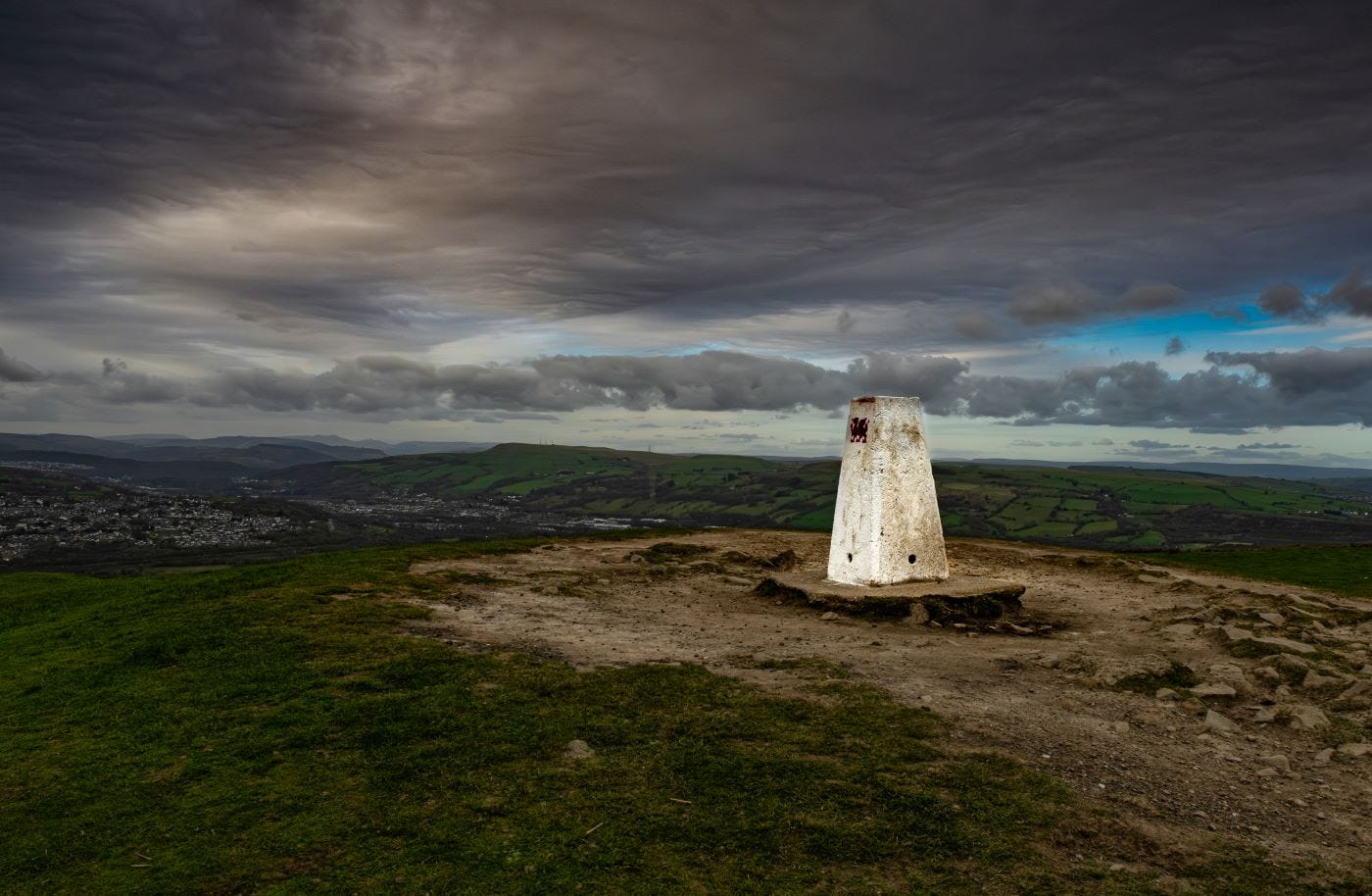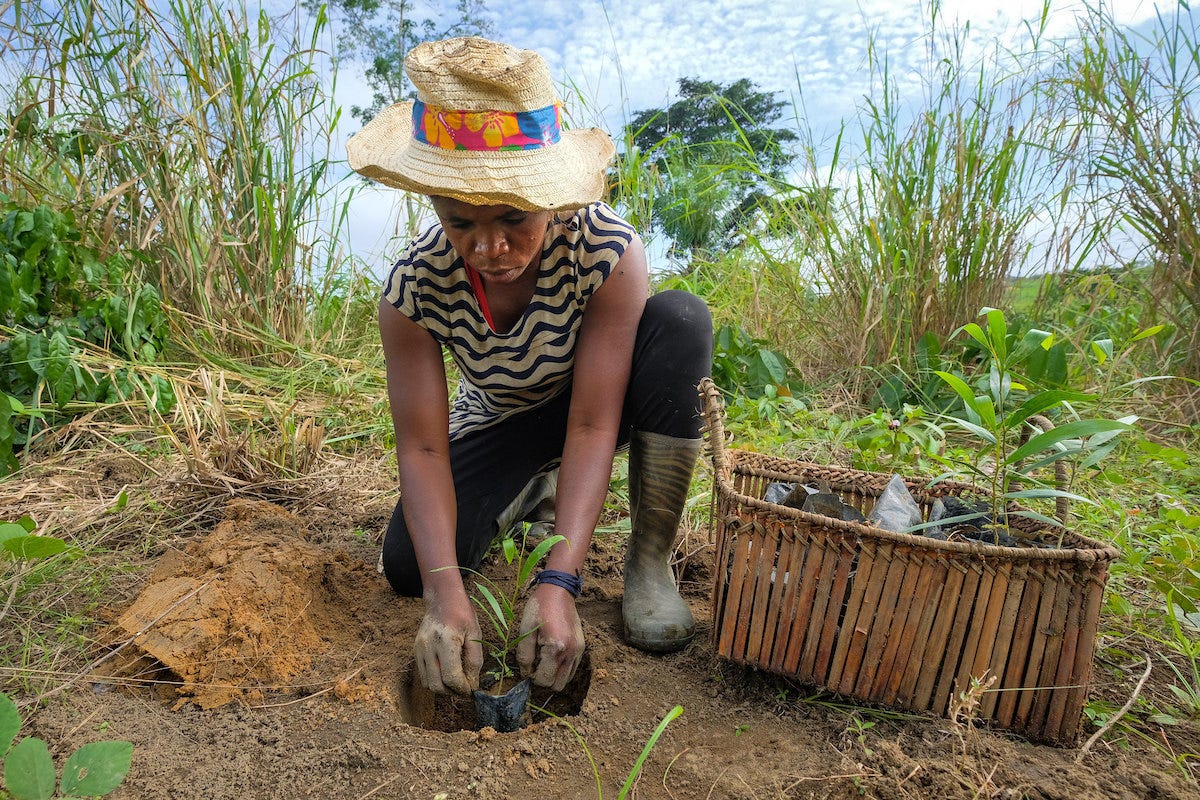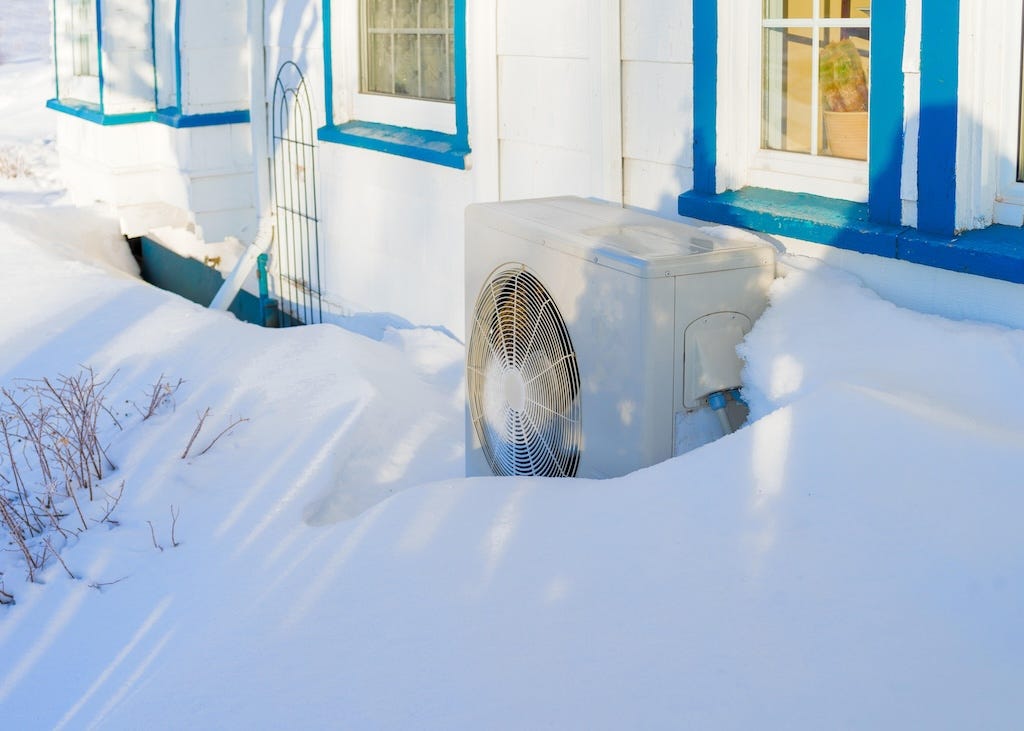When Media Molehills Hide Climate Mountains
A local BBC story speaks volumes about our news media's inability to respond appropriately to the climate crisis. But what if a responsible media was a necessary condition for our species' survival?
This is Edition #2 of The Climate Laundry. Please subscribe if you’d like to see more.
Sometimes, climate stories really do begin at home. And otherwise trivial events can illuminate far bigger issues.
Last week, an otherwise unremarkable BBC Wales story pinged my radar, because it concerned Garth Hill (Mynydd y Garth), which stands next to my parents’ house in Wales. The Garth, as it’s known to locals, was our backyard; as kids, my siblings and I would clamber muddily up and down its slopes.
According to the story, some ne'er-do-wells had defaced the concrete triangulation (or “trig”) point that stands atop the hill.
“Walkers found the trig point on Garth Hill, on which a red dragon is stencilled at the top, had been sprayed over with graffiti on Saturday,” the story ran. The graffiti read: “The dragon has choked on SUV fumes. RIP.” The article, which lacked a byline, then quoted three anonymous social media users, all outraged by the purported desecration. "Some absolute tool has vandalised the trig on mynydd Y Garth," a Twitter user hissed.
Curious, I ventured up the hill myself, but found little evidence of the “damage.” The red dragon (Y Ddraig Goch) marched unharmed upon the trig point’s west face. The graffiti shown by the BBC had adorned a different side of the concrete block, and furthermore had completely washed away: the “vandals” hadn’t used spray paint, but soot from the remains of a nearby campfire.
In short, the incident was a trivial one: here was a superficial, error-ridden bit of local news about a vanishingly minor act of protest. But that 120-word snippet, in all its throwaway glory, acted as a local reminder of a global crisis—not of the climate emergency itself, but of our media’s refusal to acknowledge it. While constituting a half-hearted attempt at rage baiting with the inclusion of three, unattributed comments, the story failed to engage with the substance of the graffiti’s message—namely, that SUVs (sports utility vehicles) are a conspicuous totem of the human excesses that are fuelling climate change. In other words, somebody at BBC Wales chose to highlight a non-story about some local vandalism that didn’t happen, in favour of an actual story about planetary vandalism that’s still happening.
Why?
The BBC piece is but a minor symptom of a long-festering illness in news media worldwide. For years, researchers have shown that coverage of protests “generally disparages protesters and hinders their role as vital actors on the political stage,” emphasising the nuisance that protesters cause, rather than addressing their demands and agendas. In the US, research shows that the media’s réactionnisme has intensified since the 1960s, with the “nuisance paradigm” increasingly replacing coverage of the causes of the protesters. From the Black Lives Matter movement to marches for a ceasefire in Gaza, the intent behind such negative framing is to trivialise the protest in question and undermine public support for it. In the UK, where senior politicians have spent a great deal of time singling out climate protesters specifically, that intent is especially hard to miss. The BBC is far from being the worst offender in this regard: the predominantly conservative British press has been shown to be both overwhelmingly unfavourable and overwhelmingly inaccurate in its coverage of climate activism.
But in any country, the citizenry is not a monolith, and a national broadcaster with a duty to inform ought to be in the business of acknowledging that. And when it comes to climate change, that goes double: “Every story is a climate story,” we’re told—and that’s because the effects of climate change are felt in everything and by everyone, whether they know it or not. Or as journalism professor Jill Hopke puts it: “Everyone is a climate reporter now” … “Rapidly rising temperatures and a corresponding shift in weather patterns is now the context for most, if not all, news stories.” Hopke has called for “a fundamental shift … in how news organizations cover climate issues, and that starts with training.”
Such an understanding opens up all sorts of opportunities for journalists to inform—and here the Garth graffiti nothingburger is a perfect example. Rather than framing the humble protest as a local nuisance, the item could have mentioned that emissions from the world’s SUVs now collectively outweigh those of most countries—a fact that this has led directly to a widespread anti-SUV movement. It could, likewise, have alluded to climate charity Possible’s finding that a new SUV purchased in 2023 releases more CO2 per kilometre than a regular car bought in 2013; or it could have informed readers that SUVs, being larger and heavier, produce more particulate emissions, which can cause serious illness and death—particularly in children (and now, apparently, dragons). Paris has now voted to triple parking fees for the vehicles, and there’s no shortage of calls for London to follow suit.
Alternatively, the unnamed reporter might have engaged with the extremely hot topic of climate protest, and the many forms it takes. By all means: highlight the views of those who object to such activism (while making some attempt to attribute said comments), but acknowledge that climate change is the catalyst for perhaps the largest mass social movement of this generation. A few weeks ago I spoke to Professor Dana Fisher, whose new book Saving Ourselves: From Climate Shocks to Climate Action, details the inexorable growth of the climate protest movement. Fisher’s work suggests that, as the climate destabilizes still further, and people’s perception of risk increases, protests will become bigger, more widespread and more disruptive. "Saving ourselves won't be popular," Fisher notes—and yet, direct action “may actually be a very effective way to increase recruitment."
That, by itself, is a fascinating phenomenon: research into the “radical flank effect” has shown that the relatively extreme actions of fringe members of a social movement can increase public support for the more moderate parts of that movement. Social media users have confidently informed me, in the wake of disruptive climate protests, that “vandalism is counterproductive”—but that’s more a feeling than a fact. For every person who takes to social media to denounce a radical activist as an “absolute tool,” there may be others who take a different view. And this truth applies to all stories, great and small; international and local. Molehills can describe mountains.
In the end, having an informed populace requires having an independent, mature press—still more a national broadcaster—that takes its responsibilities seriously. It is society’s accountability mechanism. And indeed, while such a media ecosystem might well be a necessary condition for a functioning democracy, it’s absolutely critical in the face of the threat of climate change; it essentially defines public’s conception of the threat, and has the power to spark and mediate discussions around what should be done.
For better or for worse, the media matter. But if journalists themselves don’t understand and embrace their role, they’re going to have a hard time convincing the public of that fact.
Astute readers will note that for this second edition I’ve changed my house style over to British English, which I intend to continue using. I don’t know who to apologise to for this, but please email me if you notice further irregularities. DV.
Elsewhere in climate news …
Don’t forget to check out our new podcast ON THIN ICE. Paolo Bosonin and myself are currently working on a new episode of the climate podcast that brings together legends of the adventuring world with sustainability founders and researchers to discuss the innovations and trade-offs that might (or might not) get us to an equitable space within planetary boundaries. If you’ve seen FREE SOLO, you might want to check out our first episode, with Alex Honnold himself. ON THIN ICE is on Apple, Spotify, YouTube and more.
Kate Yoder at Grist reports on the rise of heatflation: the alarming effect global warming is having on food production, and consequently on food prices. Nowhere in the world is immune: while North Africa and the Middle East look set to suffer the most, North America looks set to incur a 2% rise in food prices per year this decade due to rising heat, regardless of other economic factors. (Grist)
In some regions of the world, planting trees could in fact make warming more severe, finds a new study featured in YaleEnvironment360. That’s because trees planted in the desert, or in areas that usually receive snow, will absorb more sunlight than their surroundings—an effect that may negate the climate benefits of trees. As ever, local context matters: a climate solution that works in one place may not work in another. (e360.yale)
Emily Atkin, chief of Heated, is producing an incisive and typically acerbic series of myth-busters about EVs for US readers in the run-up to this year’s presidential election. Check it out even if you’re not an American: chances are you’ll learn something, or laugh, or both. (Heated)
Speaking of myth-busters, Jan Rosenow, possibly the world’s leading authority on heat decarbonisation, has a great new Factcheck on Carbon Brief about heat pumps. In this one, he takes apart 18 myths and incomplete understandings of heat pumps and their capabilities (though despite his valiant efforts, uninformed social media users continue to spit these very same myths at him). (Carbon Brief)
Over at Heatmap, Anna Kramer reports on the growing excitement around microreactors—tiny nuclear reactors that won’t, apparently, be useful for grid-scale power, but could help to decarbonise those hard-to-reach industrial sectors, or remote communities. It’s not yet clear whether they’ll ever actually exist, but my main thought was: should Radiant pull this off, how on Earth will such a sector be regulated? (Heatmap)
In climate denial news this week: Fossil fuel enthusiasts have been all-aflutter about Climate The Movie: The Cold Truth, a film that purports to prove that climate change isn’t happening, or that if it is, the world is getting colder. It stars such “experts” as William Happer and Richard Lindzen, both of whom work for oil industry front The Heartland Institute, along with Nobel Prize winner John Clauser, who nowadays spreads nonsense via something called The CO2 Coalition. Skeptical Science has published a fun breakdown of the myths and straight-up bullshit that the movie indulges in.










